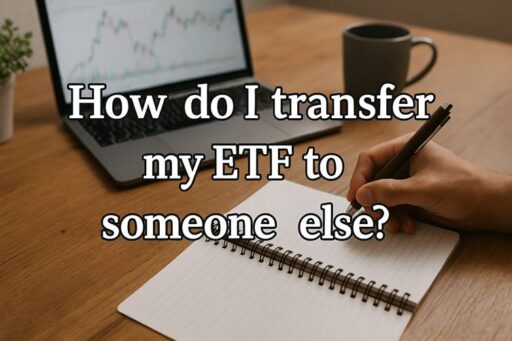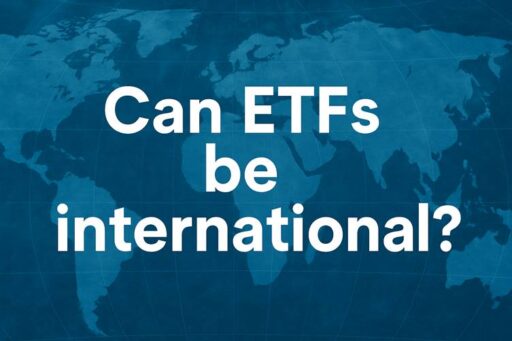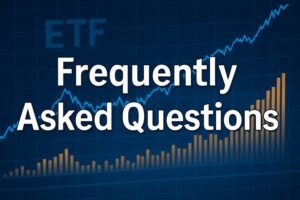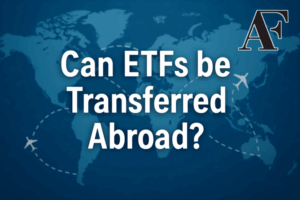Yes, ETFs can be transferred abroad through various mechanisms and settlement systems.
Exchange-traded funds (ETFs) have revolutionized global investing by providing access to diverse markets and asset classes.
However, the transfer process depends on regulatory frameworks, broker capabilities, and specific cross-border arrangements.
As investors seek greater flexibility in managing their portfolios across borders, understanding ETF transferability becomes crucial.
If you are looking to invest as an expat or high-net-worth individual, which is what I specialize in, you can email me (hello@adamfayed.com) or WhatsApp (+44-7393-450-837).
This includes if you are looking for a free expat portfolio review service to optimize your investments and identify growth prospects.
Some facts might change from the time of writing. Nothing written here is financial, legal, tax, or any kind of individual advice or a solicitation to invest.

Can ETFs be Transferred?
ETF transfers represent a fundamental aspect of modern portfolio management and investment flexibility.
The transferability of these securities enables investors to optimize their holdings across different platforms and jurisdictions.
Understanding the various transfer mechanisms helps investors make informed decisions about their investment strategies.
Can I transfer ETFs from one brokerage to another?
Transferring ETFs between brokerages is entirely possible through two primary methods: cash transfers and in-kind transfers.
The process allows investors to move their holdings without losing their investment positions.
Most modern brokerages facilitate these transfers through established protocols and systems.
Cash Transfer Method
Cash transfers involve selling existing ETF positions and moving the proceeds to a new brokerage account.
This method requires liquidating securities, which may trigger tax implications for investors.
The process includes selling investments, withdrawing proceeds, depositing funds into the new account, and repurchasing desired securities.
While straightforward, this approach can result in capital gains taxes and temporary market exposure.
In-Kind Transfer Method
In-kind transfers preserve the actual securities without liquidation, avoiding immediate tax consequences.
The Automated Customer Account Transfer Service (ACATS) facilitates electronic transfers of assets and cash between brokerages.
ACATS transfers typically complete within 5-6 business days while keeping investments active throughout the process. This method proves more tax-efficient for investors with significant capital gains.
Technical Transfer Process
The new brokerage typically initiates the transfer process by notifying the current provider about desired account movements.
Most transfers require minimal paperwork, as brokerages handle administrative requirements automatically.
Investors can request full or partial transfers depending on their specific needs and portfolio strategies.
Pros of Brokerage Transfers
- Tax efficiency through in-kind transfers
- Automated processing reduces administrative burden
- Maintains investment positions during transfer
- Access to better fees or services at a new brokerage
Cons of Brokerage Transfers
- Potential transfer fees from the outgoing broker
- Temporary account restrictions during processing
- Cash transfers trigger taxable events
- Some securities may not be transferable
How do I transfer my ETF to someone else?

Transferring ETFs to another individual involves gift transfer mechanisms that vary by brokerage platform and jurisdiction.
Most major brokerages offer gift transfer services for equity securities including ETFs.
The process requires specific documentation and compliance with applicable gift tax regulations.
Direct Brokerage Transfer Method
Many brokerages allow direct transfers from one account to another within their platform.
The process involves purchasing ETF shares and completing transfer forms designating the recipient.
Required information typically includes the recipient’s full name, Social Security number, and address.
The recipient must maintain an active brokerage account to receive the transferred securities.
Gift Transfer Platforms
Specialized platforms (like Zerodha in India) offer streamlined gift transfer services for stocks and ETFs.
The process involves selecting instruments from existing portfolios for gifting purposes.
Recipients receive notifications and must log into their accounts to accept the transfers.
New users can create accounts and accept gifts after completing registration processes.
Cash Equivalent Transfers
Alternative approaches involve selling ETF positions and transferring cash proceeds to recipients.
This method simplifies the transfer process but creates tax implications for the giver. Selling shares triggers capital gains taxes based on the cost basis of each share.
Recipients can then purchase desired ETF shares using the gifted funds.
Can ETFs be international?

ETFs demonstrate significant international capabilities through various structural and operational mechanisms.
International ETFs provide exposure to foreign markets, currencies, and asset classes while trading on domestic exchanges.
The global nature of ETF markets enables cross-border investment and portfolio diversification strategies.
How ETFs Settle
Modern ETF settlement occurs through sophisticated international systems managed by central securities depositories.
The International Central Securities Depository (ICSD) model enables streamlined cross-border ETF settlement.
This infrastructure routes stock exchange settlement to unified international environments, eliminating complex transfer agent requirements.
Global ETF Issuance Models
ETF issuance models determine settlement locations and cross-border transfer capabilities.
The ICSD and ICSDplus models facilitate international ETF trading across multiple exchanges and jurisdictions.
Major exchanges, including the London Stock Exchange, Euronext Paris, and Deutsche Börse utilize these settlement systems.
This infrastructure enables efficient cross-border position transfers without time-consuming register updates.
How is an ETF regulated?
International ETF operations require compliance with multiple regulatory jurisdictions and frameworks.
Domiciling ETFs in investor-friendly jurisdictions like Luxembourg, Ireland, and the UK enables direct register holdings.
These regulatory structures support international distribution while maintaining investor protections and tax efficiency.
Currency and Market Exposure
International ETFs provide exposure to foreign currencies, markets, and economic conditions through underlying holdings.
Investors can access emerging markets, developed international markets, and specific regional economies through internationally focused ETFs.
Currency hedging options allow investors to manage foreign exchange risk exposure.
Can I Exchange ETFs?
ETF exchange mechanisms operate through primary and secondary market structures that enable efficient trading and liquidity.
The unique creation and redemption process distinguishes ETFs from traditional mutual funds and enables continuous trading throughout market hours.
Understanding these mechanisms helps investors optimize their trading strategies.
Primary Market Operations
ETF creation and redemption occurs in the primary market between ETF sponsors and authorized participants.
Authorized participants are registered, self-clearing broker-dealers who regulate ETF share supply in secondary markets.
These entities create ETF shares in large increments called creation units through structured processes.
Are ETFs traded in the secondary market?
Yes. Individual investors typically trade ETFs in secondary markets through standard brokerage platforms.
Secondary market trading provides liquidity and price discovery throughout market hours.
The arbitrage relationship between primary and secondary markets maintains ETF prices close to net asset values.
Technical Exchange Process
The creation and redemption mechanism enables ETFs to trade like individual stocks while tracking underlying assets.
This process supports tax efficiency, enhanced liquidity, and tight tracking of benchmark indices.
Authorized participants facilitate this process by creating or redeeming shares based on market demand.
Exchange Benefits:
- Continuous trading during market hours
- High liquidity through market maker activities
- Tight bid-ask spreads on popular ETFs
- Efficient price discovery mechanisms
Exchange Limitations:
- Premium/discount variations from net asset value
- Trading halts during extreme market conditions
- Counterparty risk through authorized participants
- Complex arbitrage mechanisms for individual investors
FAQs

Is an ETF a transferable Security?
Yes, ETFs qualify as transferable securities under most regulatory frameworks and securities laws.
ETFs trade on public exchanges like individual stocks, making them fully transferable between investors.
The transferable nature enables secondary market trading, portfolio rebalancing, and inheritance planning strategies.
ETFs maintain the same transferability characteristics as other publicly traded securities.
Investors can buy, sell, transfer, and gift ETF shares through standard brokerage mechanisms.
Regulatory bodies classify ETFs as investment company securities with full transferability rights.
Is there a worldwide ETF?
Several ETFs provide global market exposure through diversified international holdings and broad geographic allocations.
These funds typically track world indices like MSCI World or FTSE Global All Cap indices.
Global ETFs offer exposure to developed and emerging markets across multiple continents and economic regions.
Popular worldwide ETFs include offerings from major providers like Vanguard, iShares, and SPDR that track comprehensive global indices.
These funds provide instant diversification across thousands of international stocks and multiple currencies.
Investors can access global markets through single ETF purchases rather than individual country funds.
Do ETFs have Transfer Agents?
Yes, ETFs utilize transfer agents to maintain shareholder records and process various administrative functions.
Transfer agents handle investment fund orders, maintain registration records, and provide ancillary services for ETF operations.
These entities facilitate the operational infrastructure supporting ETF creation, redemption, and settlement processes.
Can you buy US ETFs in Europe?
European investors face regulatory restrictions when purchasing US-domiciled ETFs directly from US markets.
The Markets in Financial Instruments Directive (MiFID II) limits European retail investor access to US ETFs lacking specific documentation.
However, European investors can access US market exposure through European-domiciled ETFs tracking US indices.
Alternative approaches include using international brokerage platforms, accessing US ETFs through professional investor classifications, or purchasing US-listed ETFs through specialized services.
Many European ETF providers offer funds tracking identical indices to popular US ETFs while complying with European regulations.
Key Takeaways
- ETFs are inherently transferable, allowing investors to move positions across brokerages, borders, and beneficiaries with flexibility.
- International ETF transfers are supported by standardized cross-border settlement protocols.
- Global ETF settlement systems reduce complexity and eliminate the need for manual register updates.
- Transferability supports portfolio optimization, estate planning, and global diversification strategies.
- Tax efficiency and liquidity are preserved in most transfer scenarios when managed properly.
- Understanding the mechanics of ETF creation, redemption, and settlement empowers smarter investment decisions across markets.
Pained by financial indecision?

Adam is an internationally recognised author on financial matters with over 830million answer views on Quora, a widely sold book on Amazon, and a contributor on Forbes.



